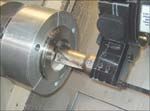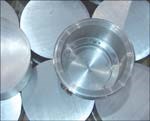Cutting Tools Expedite Product Processing
Considering the "manufacturability" of a new product before the design is finalized can help avoid costly alterations. This requires communication and cooperation between the product designers and their manufacturing counterparts.
Share




Considering the "manufacturability" of a new product before the design is finalized can help avoid costly alterations. This requires communication and cooperation between the product designers and their manufacturing counterparts.
With more than 4,500 different products, Pelco (Clovis, California), a video security systems manufacturer, offers flexibility in addressing a range of surveillance requirements. Its products are used in more than 1 million locations globally, in applications such as corporate enterprises, entertainment venues, museums and property management.
When developing a new stainless steel product, the company contacted cutting tool supplier Seco-Carboloy (Detroit, Michigan) to join its simultaneous product/process engineering team.
In response to the need for increased surveillance around ships, defense installations, power plants and other locations within the marine environment, the company began offering an explosion-proof pan-and-tilt video security system. However, introducing the corrosion-resistant product involved more than switching from aluminum to stainless steel material; it required a blank-sheet approach to product and process development.
"Our product engineers had a conceptual idea of how to introduce the stainless steel product," explains Lolo Garza, machine shop manager at Pelco. "For the power module of the unit, the design engineers envisioned a weldment comprised of three individually machined pieces."
"After analyzing the weldment drawings and existing data while the product was still in the design phase," says Daryl Serna, Seco-Carboloy senior technical specialist, "we concluded that machining the component from one large stainless steel billet would be more cost-efficient. We accurately projected the machining data based on the experience Seco-Carboloy had with metal removal rates of the TP3000 inserts, which eliminated the need to make a prototype to validate the decision to machine from the large billet."
"Working from a 316L alloy billet about 6 inches to 7 inches in diameter, we bore out the billet, machining it down to an 1/8-inch wall (basically making a tube out of it)," continues Mr. Garza. "The operations include drilling, boring, OD rough turning, finish turning, trepanning, grooving and a large amount of precision threading, and each thread has to be a G3 class fit."
Seco-Carboloy suggested its SD indexable drills with T300D coated inserts, the toughest of its universal grades, to rapidly plunge the initial hole on the ID to open up the part for heavy stock removal with a boring bar. For the roughing operation, which hogs out a large amount of stainless material, Mr. Serna recommended boring bars with the TP3000 grade, featuring a substrate and wear-resistant multi-layered coating. TP400 was also used for OD finishing.
Pelco now realizes that it made the appropriate processing decision. Machining the weldment caused the company to incur a considerable amount of extra time on the three setups. The total cycle time per module was 12 minutes. However, drilling and rough-boring the entire inside of the billet required 3 minutes.
The rough boring operation using the TP3000 with an M5 chipbreaker is performed at a speed of 550 sfpm, with a feed rate of 0.012 ipr and a 0.125-inch depth of cut. For the finishing operation, the TP400, with a 0.015-inch depth of cut and a cutting speed of 650 sfpm, is used. A feed rate of 0.008 ipr is achieved when using the MF3 chipbreaker, and 0.004 ipr is achieved with an F1 chipbreaker. Tool life ranges from 20 to 30 minutes per insert.
Because the company's explosion-proof surveillance systems carry UL and CE certification, specifications and tolerances are necessary to maintain the licenses. On a regular basis, Pelco must calibrate and document its processes, including the tools that are used. In one instance, the company's engineers produced a bearing assembly component that involved press fitting two dynamic seal O-ring bearings onto the part. The design engineers explored the possibility of pressing the part and sending it to a CNC grinding facility to grind the ID to hold the tolerance, particularly the 16 finish that was required for the dynamic seal portion. With assistance from Seco-Carboloy, the group found a processing solution that would keep the work in-house. A pilot run was carried out using a Seco-Carboloy insert, running with a 0.0002-inch tolerance from start to finish. This produced a surface finish of 8.8 and required no outside grinding.
For Pelco, working with Seco-Carboloy is more than just acquiring proper tooling for a particular operation. "It's about selecting a single-source committed carbide manufacturer and partnering for continuous improvement," says Mr. Garza.
Read Next
Building Out a Foundation for Student Machinists
Autodesk and Haas have teamed up to produce an introductory course for students that covers the basics of CAD, CAM and CNC while providing them with a portfolio part.
Read MoreSetting Up the Building Blocks for a Digital Factory
Woodward Inc. spent over a year developing an API to connect machines to its digital factory. Caron Engineering’s MiConnect has cut most of this process while also granting the shop greater access to machine information.
Read MoreRegistration Now Open for the Precision Machining Technology Show (PMTS) 2025
The precision machining industry’s premier event returns to Cleveland, OH, April 1-3.
Read More





























